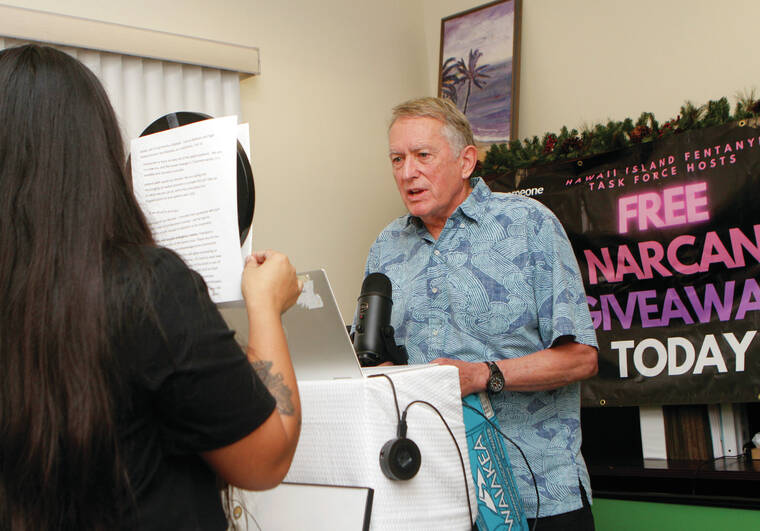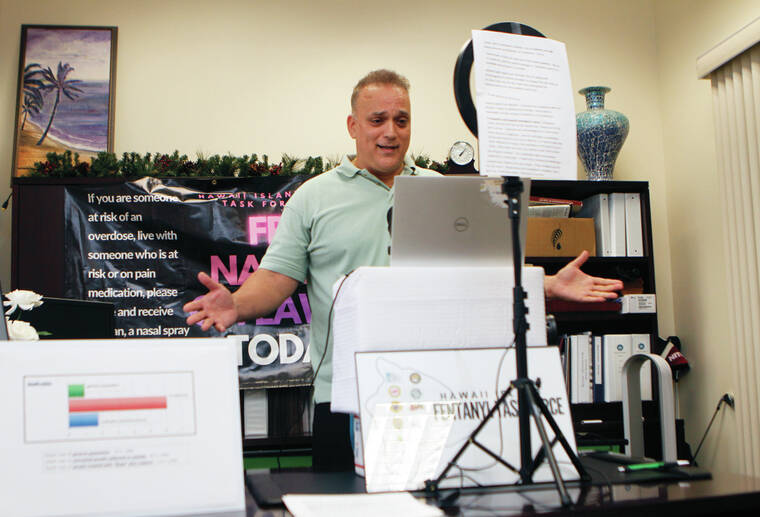Amanda DeGuair is a Big Island resident in her 18th year of recovery from an opioid addiction.
Like many suffering from opioid use disorder, DeGuair was experiencing back problems when a doctor prescribed her Vicodin. Quickly, the painkiller switched from a recovery tool to a 10-year-long dependency, with DeGuair seeking out other doctors who could keep providing pills.
“This is a progressive disease,” she said during a Hawaii Island Fentanyl Task Force press conference on Friday. “Fear of withdrawal is the biggest reason most of us stay in addiction. I thought I was going to have to suffer to get better, and I didn’t think I would survive that.”
After seeking help and support from her family, DeGuair found one of only a few doctors on the Big Island prescribing a medication called buprenorphine, also known by the brand names Suboxone and Subutex. She attributes the medication as a central part of her recovery process.
“Had I not been given Suboxone, I would not be standing here and my children would be without a mother,” she said. “I hope others find an understanding medical provider to help them live a new life as I did.”
In January, the federal government lifted restrictions on medical providers prescribing buprenorphine. Now, more Hawaii residents will have the chance to follow in DeGuair’s path to recovery.
The FDA-approved buprenorphine is used to treat opioid use disorder, acute and chronic pain, and can help with withdrawals and cravings for drugs like fentanyl and painkillers.
It is normally administered once a month for two months as a 300 milligram pill that dissolves underneath the tongue, but can also be administered in the cheek, by injection, as a skin patch, or an implant.
“Just as medications can help persons with diabetes and high blood pressure, medications like buprenorphine can help people with opioid use disorder stabilize and recover,” said Dr. Kevin Kunz, an addiction medicine specialist on the Big Island. “Can you imagine if, for any other disease, there had been such restrictions? People with diabetes having no access to insulin, people with cancer not being prescribed medication that saves their lives?”
Special registration to prescribe buprenorphine has been available for doctors since 2002, but less than two dozen medical providers on the Big Island were utilizing the medication.
“People and families seeking help for the disease of opioid addiction can now access care from nearly 500 medical providers on Hawaii Island, instead of a couple dozen, and over 5,000 medical providers statewide, instead of a few hundred,” Kunz said.
Buprenorphine is covered by all major Hawaii health insurance companies, and a month-long supply can be purchased without insurance for roughly $300.
KTA Pharmacy manager Megan Arbles confirmed buprenorphine is carried at all KTA pharmacy locations on the Big Island, although special orders may be needed for varying dosages.
Prior to the policy change, barriers limiting buprenorphine access included a required registration waiver and time-consuming training for providers, along with patient caps on the total number of individuals a prescriber could treat.
“It is ironic that providers can easily prescribe opioid medications that are potentially addictive, yet have barriers prescribing effective medications like buprenorphine for treatment of opioid use disorder,” Kunz said.
The Hawaii Island Fentanyl Task Force is encouraging providers throughout the state to take advantage of the policy change.
Fentanyl was first reported in Hawaii County in 2017, but now, an overdose death occurs every 11 days on the Big Island, mainly attributed to fentanyl. Statewide, there is roughly one overdose death every 30 hours, a rate that has increased by 25% each year for the last two years. And of all fentanyl confiscated throughout the state, roughly 60% comes from the Big Island.
“We need to decrease the demand, and one way is to decrease the craving,” said task force leader Dr. Kimo Alameda. “We’ve been distributing Narcan, which is a very important opioid overdose reversal medication, but we can go more upstream, and more upstream is buprenorphine.”
Side effects of the drug include nausea, vomiting, vertigo, and headaches among others, but in people with opioid use disorder, the medication contributes to a decrease in death rates by nearly 70%. During the first four weeks of treatment, buprenorphine is also associated with a 90% lower mortality rate than methadone.
“Taking a medication like buprenorphine is not trading one drug for another,” Kunz said. “This medication does not promote euphoria or a drug high. It takes away craving and withdrawal.”
Buprenorphine is one more tool that can now be used in Hawaii to combat addiction and the growing fentanyl and opioid epidemic.
“Buprenorphine will stabilize the brain disease of addiction and allow counseling or group participation to be more effective,” Kunz said. “We will never incarcerate or bury our way out of the opioid epidemic. We are in a new era, and the new message is: Treatment works, it is available and recovery is possible.”
Email Grant Phillips at gphillips@hawaiitribune-herald.com









